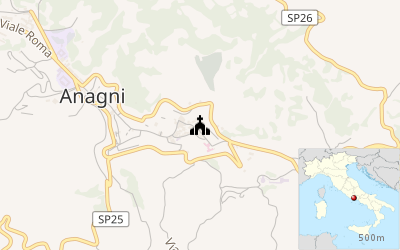Anagni Cathedral
Anagni Cathedral (Italian: Cattedrale di Santa Maria Annunziata; Cattedrale di Anagni) is a Roman Catholic cathedral in Anagni, Lazio, Italy, notable as the summer residence of the Popes for centuries (before Castel Gandolfo). It is dedicated to the Annunciation of the Blessed Virgin Mary.
History
| Location of Anagni Cathedral |
 |
The cathedral is the episcopal seat of the Diocese of Anagni-Alatri.
The church was built in a Romanesque-style during 1072-1104 patronized by the Byzantine emperor Michele VII Ducas. The interior is in a Gothic-Lombard style after the refurbishment in 1250.
The interior pavement (1231) was set in cosmatesque mosaic. The interior lunette over the main portal depicts the Madonna and child between Saints Magno and Secondina (late 13th century). The ciborium on the main altar was completed by Vassalletto in 1267. The frescoes of the apostles on the apse walls were painted in the 17th century by Borgogna. While the frescoes in the half-dome apse with was completed in the 19th century by Giovanni and Pietro Gagliardi.
Crypt
A stairwell on the left side of the church descends to the crypt, also called the Oratory of Thomas Becket, canonized in the town of Segni three years after his murder in 1170. The walls are covered with frescoes dating from 1231 to 1255 depicting biblical scenes, many severely damaged. Likely a number of artists worked in the crypt, including followers of Pietro Cavallini. Behind the altar, below a depiction of Christ and the Madonna is a depiction of St Thomas and other bishops. Other altars are dedicated to San Magno, patron of the town; also an altar dedicated to Saints Secondina, Aurelia, and Neomisia; an altar dedicated to Holy Martyrs; and finally an altar dedicated to Bishop Pietro da Salerno and the Holy Virgin Oliva. The mosaic pavement was completed by the Cosma family in 1231.[1]
References
- Comune of Anagni, entry on Cathedral.